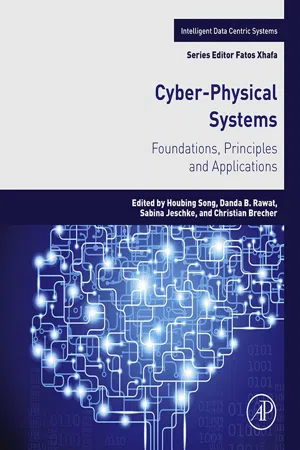
Cyber-Physical Systems
Foundations, Principles and Applications
- 514 pages
- English
- ePUB (mobile friendly)
- Available on iOS & Android
Cyber-Physical Systems
Foundations, Principles and Applications
About This Book
Cyber-Physical Systems: Foundations, Principles and Applications explores the core system science perspective needed to design and build complex cyber-physical systems. Using Systems Science's underlying theories, such as probability theory, decision theory, game theory, organizational sociology, behavioral economics, and cognitive psychology, the book addresses foundational issues central across CPS applications, including System Design -- How to design CPS to be safe, secure, and resilient in rapidly evolving environments, System Verification -- How to develop effective metrics and methods to verify and certify large and complex CPS, Real-time Control and Adaptation -- How to achieve real-time dynamic control and behavior adaptation in a diverse environments, such as clouds and in network-challenged spaces, Manufacturing -- How to harness communication, computation, and control for developing new products, reducing product concepts to realizable designs, and producing integrated software-hardware systems at a pace far exceeding today's timeline. The book is part of the Intelligent Data-Centric Systems: Sensor-Collected Intelligence series edited by Fatos Xhafa, Technical University of Catalonia.
Indexing: The books of this series are submitted to EI-Compendex and SCOPUS
- Includes in-depth coverage of the latest models and theories that unify perspectives, expressing the interacting dynamics of the computational and physical components of a system in a dynamic environment
- Focuses on new design, analysis, and verification tools that embody the scientific principles of CPS and incorporate measurement, dynamics, and control
- Covers applications in numerous sectors, including agriculture, energy, transportation, building design and automation, healthcare, and manufacturing
Frequently asked questions
Information
Characterization, Analysis, and Recommendations for Exploiting the Opportunities of Cyber-Physical Systems
† University Grenoble Alpes, Grenoble, France
‡ University of York, York, United Kingdom
§ University of Trento, Trento, Italy
¶ fortiss, Munich, Germany
** University of California, Berkeley, CA, United States
†† Technical University of Munich, Munich, Germany
Abstract
Keywords
Acknowledgments
1 Introduction
Table of contents
- Cover image
- Title page
- Table of Contents
- Copyright
- Contributors
- About the Editors
- Foreword
- Preface
- Part 1: Foundations
- Part 2: Principles
- Part 3: Applications
- Author Index
- Subject Index